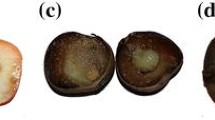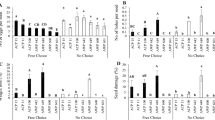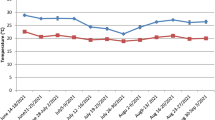Abstract
Field pea (Pisum sativum L.) is an important source of protein and income for smallholder farmers in Ethiopia. But recently, it has faced challenges due to a storage pest, the Adzuki bean beetle, Callosobruchus Chinensis (L.) (Coleoptera: Bruchidae). The response of 80 field pea genotypes managed under different soil fertility levels was evaluated under no-choice conditions for this pest infestation in the laboratory with a randomized complete block design with three replications at two locations during 2017/18. Except for thousand seed weight and percentage of seed coat weight of seeds, combined ANOVA at the two locations showed a highly significant difference (p = 0.01) for the following traits: number of eggs, date of adult emergency, number of adults, adult recovery, mean number of holes per seed, percentage of seed damage and susceptibility index. However, all traits values showed highly significant variations among genotypes. When genotypes were grown with neither rhizobium nor phosphorus, rhizobium only, and rhizobium and phosphorus, the lowest and highest values ranges of genotypic coefficient of variation (GCV) and phenotypic coefficient of variation (PCV) were observed for trait susceptibility index and thousand seed weight. Except for the percentage of seed weight loss, percentage of seed coat, thousand seed weight, and number of holes per seed, PCV was consistently higher than the corresponding GCV for more traits at each fertility level. We found moderate to high genetic advance as a percentage of mean and high heritability coupled with high genetic advance over percent mean for the traits thousand seed weight and proportion of seed coat weight across all fertility levels. Small-seeded field pea, Pisum var. abyssinicum genotypes fpcoll-1/07, fpcoll-2/07, fpcoll-21/07 and fpcoll-43/07 were moderately resistant, while the levels of the pea variety Adi were consistently more susceptible to Adzuki bean beetle than the other genotypes at all fertility levels.
Similar content being viewed by others
Data Availability
Data available on request from the authors.
References
Altieri MA, Schmidt LL, Montalba R (1998) Assessing the effects of agro-ecological soil management practices on broccoli insect pest populations. Bio-Dynamics 218:23–26
Altieri MA, Nicholls CI (2003) Soil fertility management and insect pests: harmonizing soil and plant health in agroecosystems. Soil Tillage Res 72:203–211
Altieri MA, Nicholls CI (2012) Soil fertility, biodiversity and pest management. In: Gurr GM, Wratten SD, Snyder WE, Read DMY (eds) Biodiversity and Insect Pests: Key Issues for Sustainable Management. John Wiley & Sons, Chichester, pp 72–84. https://doi.org/10.1002/9781118231838.ch5. ISBN: 978‐0‐470‐65686‐0
Argaye S (2018) Evaluation of Chickpea (Cicer arietinum L.) Genotypes Managed under Different Soil Fertility Levels for Adzuki bean beetle (Callosobruchus chinensis L.) Resistance in Ethiopia (M.Sc. Thesis, Jimma University)
Argaye S, Keneni G, Bayissa W (2021) Phenotypic diversity study on chickpea (Cicer arietinum L.) genotypes managed under different soil fertility levels for Adzuki bean beetle (Callosobruchus chinensis L.) resistance in Ethiopia. J Plant Breed Crop Sci 13:64–76
Barcchiya J, Naidu AK, Mehta AK, Upadhyay A (2018) Genetic variability, heritability and genetic advance for yield and yield components in pea (Pisum sativum L.). Int J Chem Stud 6:3324–3327
Berhane G, Berhanu A (2016) Review: Distribution and productivity of Dekoko (Pisum sativum var. abyssinicum A. Braun) in Ethiopia. GJSFR 16:45–57
Burton GW, Devane EW (1953) Estimating heritability in tall Fescue (Festuca arundinacea) from replicated clonal material. Agron J 45:478–481
Byrne OM, Hardie DC, Khan TN, Speijers J, Yan G (2008) Genetic analysis of pod and seed resistance to pea weevil in a Pisum sativum × P. fulvum interspecific cross. Aust J Agric Res 59:854–862
Central Agricultural Census Commission (2018) Ethiopian Agricultural Sample Enumeration, 2001/02.Statistical Report on Farm Management Practices. Livestock and Farm Implements. Part II. Addis Ababa, Ethiopia, 63–153p
Colasanti J, Tremblay R, Wong AY, Coneva V, Kozaki A, Mable BK (2006) The maize indeterminate flowering time regulator defines a highly conserved zinc finger protein family in higher plants. J Genet Molec Biol 7:158
Damte T, Dawd M (2003) Chickpea, lentil and grass pea insect pest research in Ethiopia: a review. In Food and Forage Legumes of Ethiopia: Progress and Prospects. Proceedings of a Workshop on Food and Forage Legumes, pp. 22–26
de Morais AA, Pinheiro JB (2012) Breeding for resistance to insect pests of stored grain. In: Fritsche-Neto R, Borém A (eds) Plant Breeding for Biotic Stress Resistance. Springer, Berlin. https://doi.org/10.1007/978-3-642-33087-2_7
Dobie P (1974) The laboratory assessment of the inherent susceptibility of maize varieties to post-harvest infestation by Sitophilus zeamais Motsch. (Coleoptera, Curculionidae). J Stored Prod Res 10:183–197
Falconer DS, Mackay FC (1996) Introduction to quantitative genetics. Longman, New York, p 464
FAOSTAT (2020) The Food and Agriculture Organization of the United Nations: The statistical database [Online]. Available at http://faostat.fao.org. Accessed on 5 Nov 2021
Girma B (2003) The state of grain marketing in Ethiopia. In Proceedings of the EDRI/IFPRI 2020 Network policy forum on toward sustainable food security in Ethiopia: Integrating the Agri-Food Chain, May 15-16, 2003, Addis Ababa, Ethiopia
Gomez KA, Gomez AA (1984) Statistical Procedures For Agricultural Research. John Wiley & Sons, New York
Gowda CLL, Kaul AK (1982) Pulses in Bangladesh, Bangladesh Agricultural Research Institute, FAO, UN, 172p
Gwinner J, Harnisch R, Mück O (1996) Manual of the prevention of post-harvest grain losses. GTZ, Germany, p 167
Hanson CH, Robinson HF, Comstock RE (1956) Biometrical studies of yield in segregating populations of korean lespedeza 1. Agron J 48:268–272
Hartley HO (1950) The maximum F-ratio as a short-cut test for heterogeneity of variance. Biometrika 37:308–312
Hasan M, Sagheer M, Saleem S, Hanif S, Akhter S, Hanif CMS (2012) Evaluation of insecticidal potential of powders of Azadirachta indica, Momordica charentia and Allium sativum against Callosobruchus chinensis (Coleoptera: Bruchidae). Pak J Entomol 34:71–73
Hill DS (1990) Pests of Stored Product and their Control, 1st edn. Cambridge University Press, London, 780p
Homan R, Yubak D (2011) Eco-friendly management of pulse beetle. JAE 12:81–90
Johnson HW, Robinson HF, Comstock RE (1955a) Genotypic and phenotypic correlations in soybeans and their implications in selection. Agron J 47:477–483
Johnson HW, Robinson HF, Comstock RW (1955b) Estimates of genetic and environment variability in soybean. Agron J 47:314–318
Kapila RK, Naryal S, Dhiman KC (2012) Analysis of genetic diversity among garden and field-pea genotypes of higher Indian Himalayas. J Plant Biochem Biotechnol 21:286–291
Katoch V, Singh P, Devi MB, Sharma A, Sharma GD, Sharma JK (2016) Study of genetic variability, trait association, path analysis and selection parameters for heterotic recombinant inbred lines of garden peas (Pisum sativum var. hortense L.) under mid-hill conditions of Himachal Pradesh India. Legume Res 39:163–169
Keneni G, Assefa F, Imtiaz M, Bekele E (2013) Genetic diversity for attributes of biological nitrogen fixation in Abyssinian field pea (Pisum sativum var. Abyssinicum) germplasm accessions. EJAST 4:1–20
Keneni G, Bekele E, Getu E, Imtiaz M, Dagne K, Assefa F (2012) Genetic Gain for Adzuki Bean Beetle (Callosobruchus chinensis L.) Resistance in Ethiopian Chickpea (Cicer arietinum L.) Genotypes. EAJS 6:43–54
Keneni G, Bekele E, Getu E, Imtiaz M, Mulatu B, Dagne K (2011a) Breeding food legumes for resistance to storage insect pests: Potential and limitations. Sustainability 3:1399–1415
Keneni G, Bekele E, Imtiaz M, Getu E, Dagne K, Assefa F (2011b) Breeding chickpea (Cicer arietinum [Fabaceae]) for better seed quality inadvertently increased susceptibility to adzuki bean beetle (Callosobruchus chinensis [Coleoptera: Bruchidae]). Int J Trop Insect Sci 31:249–261
Khattak SUK, Hamed M, Khatoon R, Mohammad T (1987) Relative susceptibility of different mung bean varieties to Callosobruchus maculatus F. (Coleoptera: Bruchidae). J Stored Prod Res 23:139–142
Kumar A, Shukla R, Singh P, Singh AK, Dubey NK (2009) Use of essential oil from Mentha arvensis L. to control storage moulds and insects in stored chickpea. J Sci Food Agric 89:2643–2649
Lambrides CJ, Imrie BC (2000) Susceptibility of mungbean varieties to the bruchid species Callosobruchus maculatus (F.), C. phaseoli (Gyll.), C. chinensis (L.), and Acanthoscelides obtectus (Say.) (Coleoptera: Chrysomelidae). Aust J Agric Res 51:85–89
Lattanzio V, Terzano R, Cicco N, Cardinali A, Di Venere D, Linsalata V (2005) Seed coat tannins and bruchid resistance in stored cowpea seeds. J Sci Food Agric 85:839–846
Mendesil E, Shumeta Z, Anderson P, Ramert B (2016) Smallholder farmers’ knowledge, perceptions and management of pea weevil in north and north-western Ethiopia. J Crop Prot 81:30–37
Mensah G (1986) Infestation potential of Callosobruchus maculatus (Fab.) (Coleoptera: Bruchidae) on cowpea cultivars stored under subtropical conditions. Int J Trop Insect Sci 7:781–784
Mussa J (2017) Genetic improvement of adapted Ethiopian chickpea (Callosobruchus maculatus L.) cultivar for drought tolerance through conventional and marker assisted backcross breeding methods (Doctoral Dissertation, Addis Ababa University)
Nandjui J, Adja NA, Kouadio KT, N’gouandi MPA, Idrissou L (2018) Impact of soil fertility management practices on insect pests and diseases of maize in southwest Cote d’Ivoire. J. Appl. Biosci. 127:12809–12819
Negash F, Mulualem T (2014) The effect of ploughing, fertilizer application and weeding frequency on field pea (Pisum sativum L.) production at Angacha South Ethiopia. TJAVS 2:125–131
Pandey M, Singh VB, Yadav GC, Tyagi N, Vishen GS, Bhargav KK, Pandey P (2017) Correlation and path coefficient analysis among different traits in genotypes of vegetable pea. Veg Sci 44:139–141
Pandey RL, Tiwari AS (1983) Heritability and genetic gain in chickpea. Int Chickpea Newslett 9:5–6
Phelan PL, Mason JF, Stinner BR (1995) Soil fertility management and host preference by European corn borer, Ostrinia nubilalis, on Zea mays: a comparison of organic and conventional chemical farming. Agric Ecosyst Environ 56:1–8
Ramesh P, Singh M, Rao AS (2005) Organic farming: Its relevance to the Indian context. Curr Sci 88:561–568
Robinson HF, Comstock RE, Harvey PH (1949) Estimates of heritability and the degree of dominance in corn. Agron J 41:353–359
Statistical Analysis Software (SAS ) (2010) Version 9.3. SAS Institute Inc., Cary
Shaheen FA, Khaliq A, Aslam M (2006) Resistance of chickpea (Cicer arietinum L.) cultivars against pulse beetle. Pak J Bot 38:1237
Shahidur R, Chilot Y, Befekadu B, Solomon L (2010) Pules value chain in Ethiopia; constraints and opportunities for enhancing exports. Working Paper July 2010. International Food Policy Research Institute, USA
Singh RK, Chaudhary BD (1985) Line x Tester analysis. Biometrical Methods in Quantitative Genetic Analysis, pp. 215–223
Singh D, Boopathi T (2022) Callosobruchus chinensis (Coleoptera: Chrysomelidae): Biology, life table parameters, host preferences, and evaluation of green gram germplasm for resistance. J Stored Prod Res 95:101912
Solleti SK, Bakshi S, Purkayastha J, Panda SK, Sahoo L (2008) Transgenic cowpea (Vigna unguiculata) seeds expressing a bean α-amylase inhibitor 1 confer resistance to storage pests, bruchid beetles. Plant Cell Rep 27(12):1841–1850
Somta P, Ammaranan C, Ooi PAC, Srinives P (2007) Inheritance of seed resistance to bruchids in cultivated mung bean (Vigna radiata, L. Wilczek). Euphytica 155:47–55
Talukder FA (2006) Plant products as potential stored-product insect management agents-A mini review. Emir J Food Agric 18:17–32
Acknowledgements
We would like to thank the Ethiopian Institute of Agricultural Research for funding this research project. We are also grateful to the Melkasa and Kulumsa Agricultural Research Centers.
Author information
Authors and Affiliations
Contributions
Conceptualization: D.T., E.M. and G.K.; Experimentation and data collection: D.T.; Data curation: D.T and E.M.; Formal analysis: D.T.; Writing–original draft preparation: D.T. and E.M.; Writing: D.T. and E.M. and G.K.; Review and editing: D.T., E.M. and G.K.; Supervision: E.M. and G.K.; Funding acquisition: G.K.; Project administration: E.M. and G.K. All authors read and approved the manuscript.
Corresponding author
Ethics declarations
Conflict of interest
The authors declare that they have no conflict of interest.
Additional information
Publisher's Note
Springer Nature remains neutral with regard to jurisdictional claims in published maps and institutional affiliations.
Rights and permissions
Springer Nature or its licensor (e.g. a society or other partner) holds exclusive rights to this article under a publishing agreement with the author(s) or other rightsholder(s); author self-archiving of the accepted manuscript version of this article is solely governed by the terms of such publishing agreement and applicable law.
About this article
Cite this article
Tesfaye, D., Mendesil, E. & Keneni, G. Response of field pea genotypes to the infestation of Adzuki bean beetle (Callosobruchus chinensis L.) under different soil fertility regimes and locations in Ethiopia. Int J Trop Insect Sci 43, 115–128 (2023). https://doi.org/10.1007/s42690-022-00928-x
Received:
Accepted:
Published:
Issue Date:
DOI: https://doi.org/10.1007/s42690-022-00928-x





